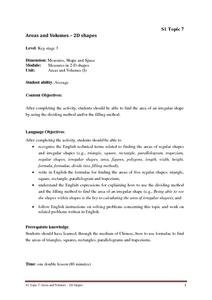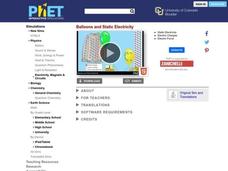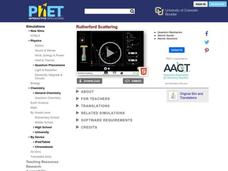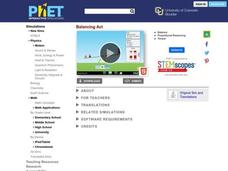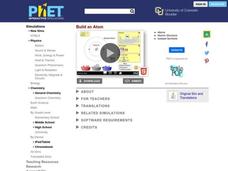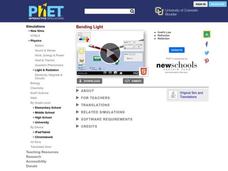Scholastic
Make Hooting Owls with Your Class!
Kids create their own hooting owls using the template provided and art supplies. Pair the activity with the book, 10 Hooting Owls as suggested here, or on its own as part of a unit on owls or nocturnal animals.
Pearson
Main Idea
The main idea of this resource is that you should take a look if you're planning to teach main ideas in your class! Cover just about everything you need to know about main ideas with a packet of materials that includes information and...
Government of Hong Kong
Areas and Volumes - 2D Shapes
Unfortunately for young mathematicians, the world isn't made entirely of parallelograms, triangles, and trapezoids. After first learning the area formulas for these common shapes, students apply this new knowledge to...
NYSU
Understand a Fraction as a Number on a Number Line
Piece by piece young scholars build a basic understanding of fractions in a Common Core-designed elementary math lesson. Through a series of hands-on activities and journaling exercises, and with the help of multiple...
Curated OER
Basic English Sentence Patterns
A simple set of practice sheets deals with sentence structure and patterns. The 117-page packet includes 10 units of skills, varying from identifying parts of speech in a sentence to writing the correct part to make a sentence...
British Council
Learning English through Short Stories
Use short stories to teach English? Yes! Designed as a professional development opportunity for English language teachers, the ideas in this booklet can easily be adapted to advanced ESL/ELL classes.
PhET
Balloons and Static Electricity
Like all electricity, static electricity flows at the speed of light, or 186,282 miles/second. The interactive simulation shows how like charges repel like charges and opposites attract. The user can choose either one or two balloons, a...
PhET
Concentration
When no more solute can be dissolved into a solvent, the solution has reached saturation. The interactive simulation allows learners to manipulate a solution in order to measure its concentration. The amount of solvent, the amount and...
PhET
Molarity
All chemists know that moles are made of molecules. Individuals see how changes in the amount of solute affect the concentration of the solutions. By manipulating solute amounts (moles), solution volume (liters), and solute types, the...
PhET
Rutherford Scattering
Rutherford performed his famous experiment in 1907 with Marsden, showing the true atomic structure. This interactive simulation compares Rutherford's historical experiment to the Plum pudding model of the atom. In both models, alpha...
PhET
Neuron
Neurons send electrical signals throughout a body based on chemical communication. Individuals stimulate a neuron to see the effects. They notice the sodium-potassium channels along with ions, concentrations, and a membrane potential...
PHET
Atomic Interactions
Who knew atoms could be attracted to each other? A simulation allows learners to see how forces between atoms influence the attraction between them. Classes see the attractive and repulsive forces adjusting as distance between atoms...
PHET
Balancing Act
How can a teeter-totter balance when the two people are different sizes? Show classes how this works through a simulation. Scholars play with a teeter-totter to show how different masses and their placement affect balance. Once they have...
PHET
Band Structure
Electricity travels at the speed of light, 186,000 miles per second. Through a simulation, classes see how the structure of energy bands in crystals of atoms determines how materials conduct electricity. Participants can change the...
PHET
Battery-Resistor Circuit
Don't be resistant to physics! A simulation shows classes how a resistor works. Change the battery voltage and resistance to show how this affects the flow of electrons. Temperature and amps measurements are shown for the system as...
PHET
Battery Voltage
Pupils explore modern batteries and how they work by viewing a simple simulation. It shows electrons moving around the insides and if the voltage is changed, little people move the particles from one end to the other — an entertaining...
PHET
Color Vision
Humans can only see visible light, but some insects can see ultraviolet light. Through a simulation, pupils explore how we see colors using one bulb. It moves on to demonstrate how we see colors by mixing three different bulbs (red,...
PHET
Capacitor Lab
The first capacitor was a Leyden jar, invented in 1745. Physics scholars explore capacitors in an engaging simulation. They may view one or set up circuits which contain two to three either in series or parallel. Other views include...
PHET
Build an Atom
Scholars build specific elements by creating a model of its atomic structure. Objects they can include are protons, nuetrons, electrons, orbits, clouds, charge, and mass number. Simulation ends with questions to challenge individuals'...
PHET
Alpha Decay
There are different types of radioactive decay, and alpha decay is when there are too many protons in a nucleus. Here is a simulation that shows alpha particles being emitted from a polonium nucleus. Learners see how radioactive decay...
PHET
Bending Light
Different colors of the spectrum travel at different speeds through media, causing them to refract at different angles—which allows humans to see their colors. Through a simulation, pupils see how air, water, and other media bend light....
PHET
Conductivity
Human bodies can conduct electricity—that doesn't sound like it would feel good! Learners explore conductivity through the use of this simulation. They see why metals conduct electricity and plastics don't and why some materials will...
PHET
Double Wells and Covalent Bonds
Quantum tunneling plays an important role in nuclear fusion, the energy source of the sun. This simulation explores tunneling, double wells, and covalent bonds by allowing individuals to manipulate potential and total energy to learn...
World Intellectual Property Organization
Learn from the Past, Create the Future: Inventions and Patents
3D printers, selfie sticks, smart watches. GPS, self-driving cars, YouTube. Imagine life without inventions. Believe it or not, these items were all invented in the last 10 years. Inventions, and the inventors responsible for them,...
Other popular searches
- French Grammar Worksheets En
- Post En
- Phonics Endings En
- By Ens
- Stilling En
- En Ts
- Sending En
- Period En
- En Family Words
- Reggae en Espaâ¿â¿ol Plena
- Font En
- En El Restaurante


